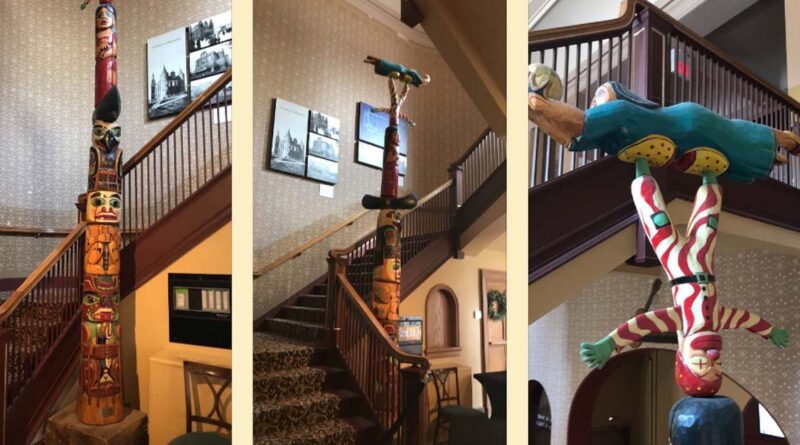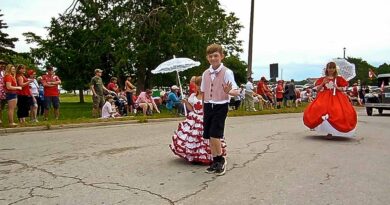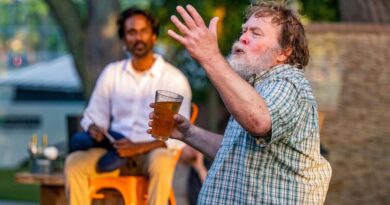Analysis: Opera House Art Controversy
By John Swartz
Monday night Orillia council made a decision to take down the story pole – at a cost of $1,500 – from the foyer of the Opera House with the primary intent of having it repaired.
That’s half the story. A report from the health and safety committee noted several cracks, which can be seen very easily and that the top two figures:
“It was reported that the top two figures tend to wobble and rotate when dusted, as demonstrated during my visit,” the report writer said.
“I don’t know who did the survey on the cracks. They should be talking to me about that,” said the creator of the pole, Jimi McKee. He also noted not all cracks are created equal, some are structural, some are cosmetic. He has opportunity to look over his works and will express concerns to art owners if he sees anything of consequence, like he did with the owners of his art at the Bass Pro Shop at Vaughan Mills.
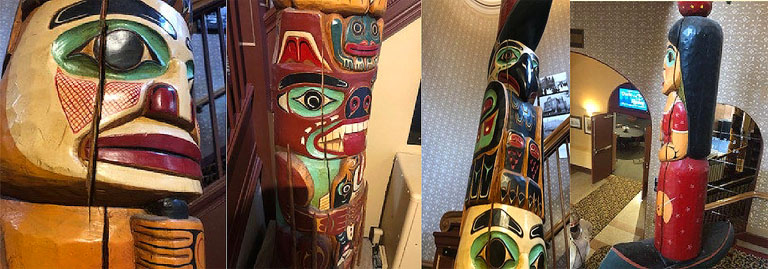
“There are cracks in those poles (at Bass Pro) that I have been after them for 10 to 15 years to fill in with epoxy and they still haven’t done it. Our little pole here is not going to fall down and kill somebody. I have a steel bracket attaching it to the banister,” McKee said.
“The upside down clown, I put it on a one inch steel pin that spins. So whenever I go in there I spin the clown and the angel 100% and when people see it they think, ‘what the… that wasn’t that way before’.
“I haven’t looked where the pin on the head of the clown attaches, that’s the only possibility she might have been talking about. I put that pin into the head of the clown, I think about 8 inches. Anytime something goes wrong with my art in this town, nobody gets back to me. They take all these other routes.” McKee is referring to the carvings he did on the trees outside the Opera House, which have been removed.
So if the writer of the report had bothered to ask the artist, they would have found out one of the things everyone is worried about is really supposed to be the way it is.
As to the cracks, “Every log gets charm cracks. The big arch at Bass Pro, I’ll bet you it’s two inches wide by four feet long,” McKee said.
“You can’t please everybody. Now they’re saying they’re going to take it down, which is really stupid because I’ve got totem poles that have far more cracks in it than that. I can fix any cracks in it in a day.”
Furthermore, the pole has a rod running through the bottom portion of it and is braced to the stair railing.
“That railing in the opera house is solid steel and the bracket is steel. It would take a hurricane to knock that pole over,” McKee said.
“All these people should be calling me with questions. I’m the one who knows about the consistency of totem poles.”
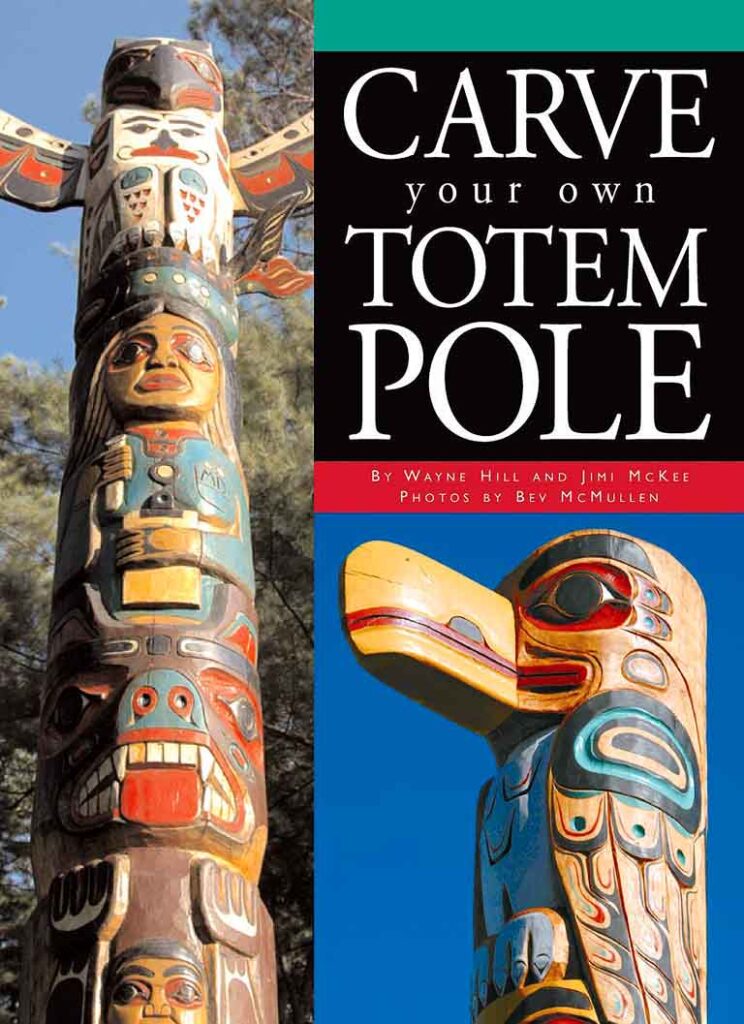
That is not understatement. He authored a book with Wayne Hill about Canadian totem poles called Carve Your Own Totem Pole, which is an illustrated guide and gives the history of totem pole carving and its West Coast native traditions, techniques and patterns. Hill has been teaching about totem poles and carving at Brock University for 20 years – and he’s Cree. The two have worked on many projects together over the years, so McKee really is an expert on this subject.
In fact the book carries an endorsement.
“Jimmy Three Wales, a Haida honoured elder said, the epilogue basically says, “I am please to support them and I can think it will nothing but good for passing on to the East Coast some of our West Coast culture,” McKee said.
So in making the report the City consulted with everyone from the Art in Public Places Committee to someone in Rama, the health and safety committee, but did not speak to the expert in their own back yard, which left McKee in the position of having to defend his art and work.
The Repugnant Part Of The Story
There is a darker issue to all this. One woman who said she is West coast Native complained to Opera House staff she “took exception to the clown and called it offensive.”
The second complaint is more ominous. I came from someone named Skén:nen kénha, who is the administrative director of the Ontario Presents Contact Ontour event happening in September at the Opera House. She demanded the art be removed for the event.
The stated reasons are:
- A totem is not representative of the territorial Peoples of the region of which Orillia sites.
- A totem is also a spiritual representative of the ancestral identities affiliated with the graves or burial areas.
- The design for the top third of the totem, in the form of circus figures is insulting, denigrating and to be frank, racist in its appropriated configuration of Indigenous culture, spiritual history/story and proud identity for West Coast Indigenous Peoples.
If one is of a position, one should be a little more circumspect of the limit of one’s knowledge. As we will see this person is wrong on all three counts. It’s especially egregious to level charges of racism.
Point one doesn’t wash at all because the pole is representive of the territorial people, the Chippewas, the European settlers of Orillia and the history of Orillia. Totems are many things and are most definitely from and part of Native culture. This, however, is not a totem.
“It’s one of the biggest pieces of sculpture folk art in Ontario celebrating a town,” McKee said. He prefers art like this, of which there are other examples, be called story poles.
“Any vertical art, any vertical sculpture in Ontario, everybody calls a totem pole. If it’s a log and it’s 8, 10, 12, 15, 20 foot high, what do you call it? A totem pole. We really shouldn’t do that. We should get rid of the world totem pole. It relates to mythical beings and there’s nothing on there mythical. That’s all the stuff in Orillia.”
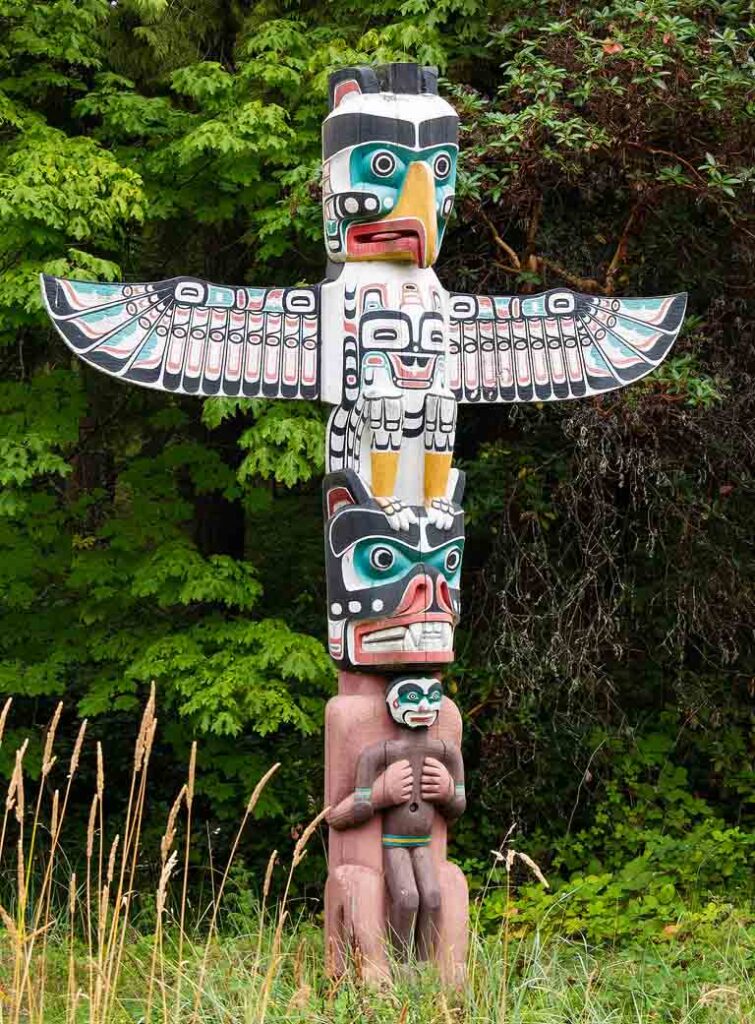
West Coast Natives are protective of their art, and there are many forms of totem poles from the west, not just one. The Kwakiutl Nation, for example uses 6 specific motifs and specific colours arranged to make the figures of their totem poles. We can find no instance of them levelling charges of racism, or appropriation, They take issue with those claiming to have made one that doesn’t conform (i.e 7 motifs, not Kwakiutl), they make a distinction between their poles and others, but that is the extent of it, no offence to their souls taken, they just simply deny the right of anyone to make a claim when it’s not authentically made (totems are still made, they aren’t all old).
There are totems all over Canada that do not look at all like the ones on the West Coast. In fact McKee found an old one in a farmer’s field on the other side of the lake (the bush part of the farm) which had fallen down and it has all kinds of colours and carving techniques not found on the West Coast at all. Should the person making the charge be offended by the totems of the Chippewas, the Hurons, the Mohawks or European settlers who like the idea because they aren’t the same as the West Coast examples?
There are some traditions surrounding totem pole making that are relatively common regardless of geography. One is they tell a story.
“When I first did it, I spent two years designing that and it was actually complete with the upside down clown, that was the end of it. That was to celebrate the comedy, the opera and the other entertainment. About a month later I had this wonderful a-ha moment. I thought I’m working in Native culture and I’ve always been dedicated to it, so I drew up this flying Native angel with the world in her hand and I went to the town and they said, ‘what a great idea.’ So that’s why I put it on top,” McKee said.
All the elements relate to the history of Orillia from the giving away of the land by Chief Yellowhead (he did not have a choice) to the recognition of what goes on inside the Opera House, the clown.
Point 2 accompanying the demand for its removal is moot as has already been explained why totems are made and they are not for one narrow purpose as the complainer states.
Point three however, with its racism charge, is so far off base, if one understands what totems are about and why they are made, it’s almost not worth considering, except for its own offensiveness. The complainer assumes its about Native culture, which it is not. From bottom to top, it tells one story, just not the one the complainer, from their narrow understanding, thinks it should tell.
“I spent a long time trying to get everything in there,” he said.
“It’s crazy, if they want something changed, I’ll change it, that’s not a big deal If they don’t like the clown I’ll get rid of the clown. Really the clown is correct. What isn’t correct is the flying Native angel with the world in her hands. They can remove that.”
So the one part that McKee says is definitely a Native inspired element, the angel, is the part that doesn’t fit the story and is out of place. As to the claim it’s not West Coast, on that the complainer is right.
McKee amplified that point in response to staff responding to a question from councillor Jay Fallis regarding whether staff was going to get input from ‘the west coast’ on the appropriateness of the pole. The audio for many portions of Monday’s meeting were garbage so the exact words can’t be quoted, but the University of British Columbia was mentioned.
“One of her comments was, well we’re going to call the West Coast conglomerate of the chiefs on the West Cost to see what their opinion is. I sent an email in capital letters saying, ‘in no circumstance do you do something that stupid. It has nothing to do with the West Coast, other than the word totem pole, which we are going to correct as ‘town sculpture’; if you open Pandora’s Box by saying this totem pole has this on it and it’s got an upside down angel on it.’ Then of course one of the chiefs out there is going to complain. My partner, Wayne Hill, has completed about 400 totem poles, he’s none too pleased about this.”
Council’s Debate
The opening comment from councillor Ted Emond gave the other councillors the out of not bowing to the offensiveness of the complaint.
“My understanding is they appropriated the artform of the Western Indigenous communities who have used totems to be memorials to families, but also to welcome people to communities, to recognize history of communities and a number of other things and in appropriating that, Jimmy and Wayne have over 40 years of experience in using that artform.”
Using forms of the word appropriate was not maybe the best choice since it implies taking something from someone else and claiming it as your own, which is most definitely not what McKee has done. It’s kind of like saying Mr. Dodge can’t put wheels on his cars because Ford did it first. Emond continued:
“This piece obviously does need repair and I think that’s essential. I also think it needs interpretation. I think it needs to explain how these artists have used a legitimate artform and in the very use of the artform have honoured the Indigenous peoples of the west. I think that needs to be explained to those who jump to a conclusion based on their own interpretation bias.”
“I don’t think this piece needs to be abandoned, short of its structural inability to be repaired.”
Here, that is not unreasonable, if one is going to take only staff’s word. As we have seen, things may not be as dire as staff believes. Then we get to the part Emond is to be applauded for.
“We have to be very cautious we don’t jump to simple solutions like getting rid of things, but rather to invest the time and energy to really understanding the culture of our Indigenous people so we can integrate that into what we do as they have integrated us into their lives.”
“I would like to see this repaired and retained.”
The rest of council fell into line saying, ‘oh sure’ let’s make sure it doesn’t fall down, and very little about the allegations raised. However the rest of the motion may create a can of worms if staff goes coastal for advice. If they listen to McKee, they’ll save $1,500 too. It reads:
“AND THAT staff be directed to undertake additional consultation and investigation with the artist and other Indigenous groups regarding options for repairs, possible updates to the artwork, in addition to an interpretation regarding its relevance in Orillia and report back.”
“I need to see it, we can take the angel and the clown down in 5 minutes. If that’s the question, let’s take that down and address that. If they want, I’ll put two new creatures up there that relate to the town, something a little more modern with what’s going on in the town. In the last 20 years I can think of lots of things I can carve,” McKee said.
The conference in question is from September 14 to 17. Our suggestion, if McKee surveys the pole and finds it does need to be removed for repair, take it down for that purpose, but wait until September 18. Under no circumstance should the complainer levelling charges get to believe they carried the day.
To read McKee’s complete description of the elements of the pole see Monday’s Council Preview story.
(Photos by Swartz – SUNonline/Orillia; Images Supplied)

